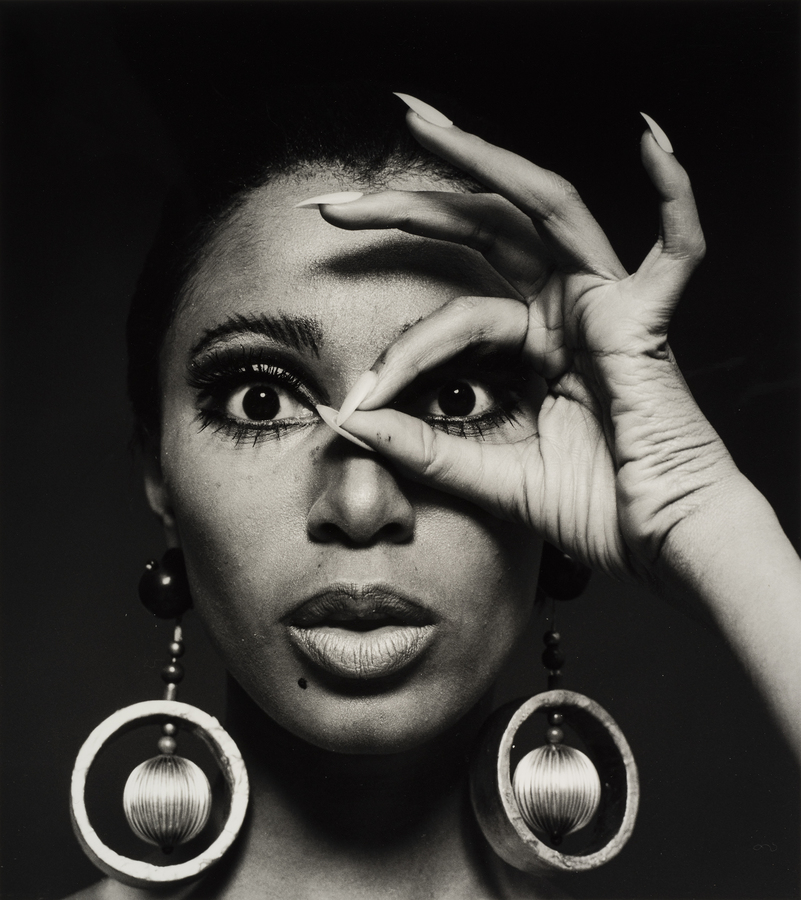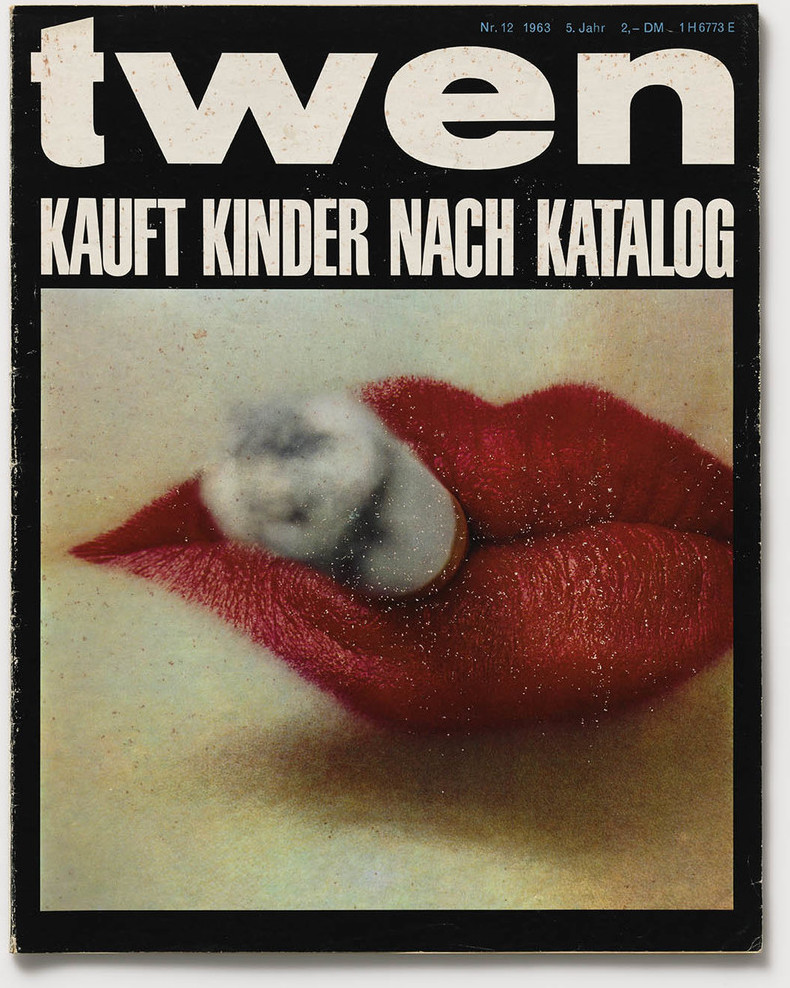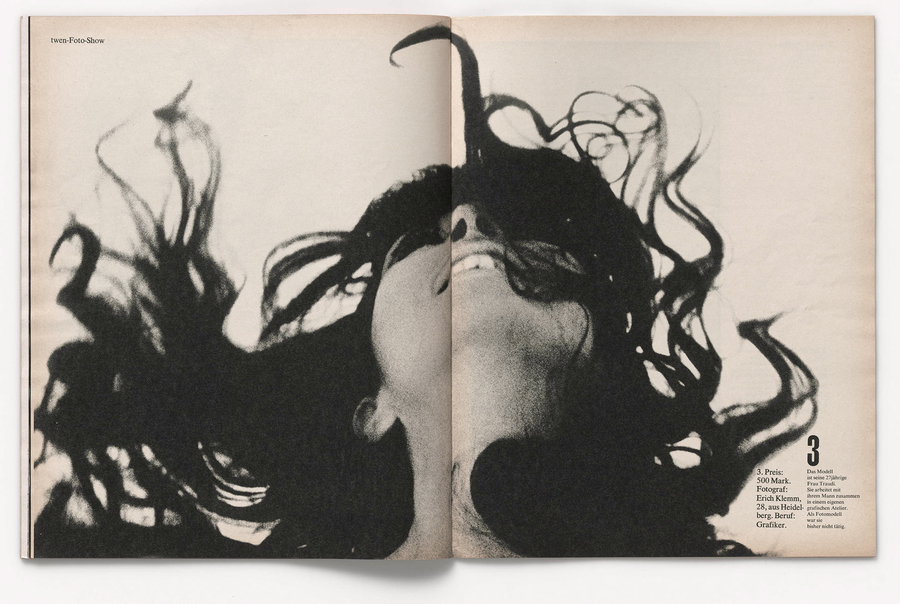ALL TOMORROW’S PARTIES
TWEN: DAS MAGAZIN DER SECHZIGER JAHRE
15.03.–18.05.2025

ALL TOMORROW’S PARTIES
TWEN: DAS MAGAZIN DER SECHZIGER JAHRE
15.03.–18.05.2025
Provocative, sensual, new!
At the end of the 1950s, a magazine burst onto the staid German-language magazine market whose influence on subsequent journalism could hardly have been greater. twen, a magazine cloaked in deep, existentialist black, wrote against the old, focussed on hedonism, sexual liberation, consumerism and youth culture and thus shaped the cultural thinking of an entire generation. The radical design of art director Willy Fleckhaus also made twen the blueprint for a number of magazines internationally: The Face in England, Actuel in France and Der Wiener in Austria would have been inconceivable without the magazine, which was published in Cologne from 1959 to 1971.

ALL TOMORROW’S PARTIES
TWEN: DAS MAGAZIN DER SECHZIGER JAHRE
15.03.–18.05.2025
EXHBITION OPENING: THURSDAY | 13.03.2025 | 7 pm
Provocative, sensual, new!
At the end of the 1950s, a magazine burst onto the staid German-language magazine market whose influence on subsequent journalism could hardly have been greater. twen, a magazine cloaked in deep, existentialist black, wrote against the old, focussed on hedonism, sexual liberation, consumerism and youth culture and thus shaped the cultural thinking of an entire generation. The radical design of art director Willy Fleckhaus also made twen the blueprint for a number of magazines internationally: The Face in England, Actuel in France and Der Wiener in Austria would have been inconceivable without the magazine, which was published in Cologne from 1959 to 1971.
twen translated youthful rebellion into great visuals. Fleckhaus elevated the double-page spread to a medium in its own right with cropped photos running across the page, repeatedly unprinted space and pictorial lettering. Under his direction, the magazine became a showcase for international camera art and a springboard for young talents such as Charlotte March, Christa Peters and Will McBride with photo spreads by Irving Penn, René Burri and William Klein.
In its choice of topics, the magazine was decidedly political, pacifist, anti-Nazi, international and enlightened, especially in the early years. With titles and stories on dropoutism and abortion, APO (extra-parliamentary opposition), equal rights, homosexuality, racism and anti-Semitism, the magazine took up arms against outdated ideologies and norms, false ethics and rigid morals. The contemporary public saw it either as the expression of a new age or as a symbol of moral decay. The magazine was either loved or scolded, showered with international design awards and placed on the Index for Publications Harmful to Young Persons. There seemed to be nothing in between. As if under a burning glass, twen reflects the cultural awakening of the 1960s, its achievements and its contradictions, which continue to have an impact today.
The exhibition at WestLicht shows the pioneering design of twen and the enduring topicality of its themes through selected photographs, double-page spreads, magazine covers and picture series by iconic photographers such as Bruce Davidson, Will McBride, F.C. Gundlach, Charlotte March, Horst H. Baumann, Ulrich Mack, Art Kane, Barbara Niggl and Thomas Hoepker.
twen translated youthful rebellion into great visuals. Fleckhaus elevated the double-page spread to a medium in its own right with cropped photos running across the page, repeatedly unprinted space and pictorial lettering. Under his direction, the magazine became a showcase for international camera art and a springboard for young talents such as Charlotte March, Christa Peters and Will McBride with photo spreads by Irving Penn, René Burri and William Klein.
In its choice of topics, the magazine was decidedly political, pacifist, anti-Nazi, international and enlightened, especially in the early years. With titles and stories on dropoutism and abortion, APO (extra-parliamentary opposition), equal rights, homosexuality, racism and anti-Semitism, the magazine took up arms against outdated ideologies and norms, false ethics and rigid morals. The contemporary public saw it either as the expression of a new age or as a symbol of moral decay. The magazine was either loved or scolded, showered with international design awards and placed on the Index for Publications Harmful to Young Persons. There seemed to be nothing in between. As if under a burning glass, twen reflects the cultural awakening of the 1960s, its achievements and its contradictions, which continue to have an impact today.
The exhibition at WestLicht shows the pioneering design of twen and the enduring topicality of its themes through selected photographs, double-page spreads, magazine covers and picture series by iconic photographers such as Bruce Davidson, Will McBride, F.C. Gundlach, Charlotte March, Horst H. Baumann, Ulrich Mack, Art Kane, Barbara Niggl and Thomas Hoepker.

Charlotte March
Donyale Luna with jewellery from Boutique Darling, 1966
© Deichtorhallen Hamburg/ Harald Falckenberg - Estate
Charlotte March

twen 12/1963, Cover
Photography Irving Penn
Courtesy Sammlung Hans-Michael Koetzle

twen 2/1968, double page
Photography Erich Klemm
Courtesy Sammlung Hans-Michael Koetzle
ALL TOMORROW’S PARTIES
TWEN: DAS MAGAZIN DER SECHZIGER JAHRE
15.03.–18.05.2025
Opening hours:
TUE, WED, FRI: 2–7 pm
THU: 2–9 pm
SAT, SUN, HOLIDAYS: 11 am–7 pm
MON: closed
ALL TOMORROW’S PARTIES
TWEN: DAS MAGAZIN DER SECHZIGER JAHRE
15.03.–18.05.2025
Opening hours:
TUE, WED, FRI: 2–7 pm
THU: 2–9 pm
SAT, SUN, HOLIDAYS: 11 am–7 pm
MON: closed